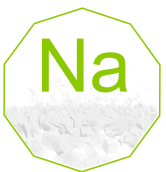Sodium
Atomic mass:22.990 u

Sodium: Element Overview
Basic Information
- Symbol: Na
- Atomic Number: 11
- Atomic Weight: 22.98976928 u
- Element Category: Alkali metal
- Group: 1
- Period: 3
Physical Properties
- Phase at Room Temperature: Solid
- Melting Point: 97.72 °C (207.9 °F)
- Boiling Point: 883 °C (1621.4 °F)
- Density: 0.968 g/cm³ at 20 °C
- Color: Silvery-white
Chemical Properties
- Electronegativity: 0.93 (Pauling scale)
- Ionization Energies:
- First: 495.8 kJ/mol
- Second: 4562 kJ/mol
- Third: 6910.3 kJ/mol
Isotopes
- Stable Isotope: Sodium has one stable isotope: Na-23.
- Radioisotopes: Several, including Na-22 and Na-24.
Occurrence and Production
- Natural Abundance: Sodium is the sixth most abundant element in the Earth’s crust.
- Sources: Found in various minerals such as halite (rock salt), soda ash, and feldspar.
- Production: Commercially produced by the electrolysis of molten sodium chloride.
Uses and Applications
- Industry: Used in the manufacture of chemicals, such as sodium hydroxide, sodium carbonate, and sodium peroxide.
- Metallurgy: Used as a reducing agent and to refine metals such as zirconium and potassium.
- Medicine: Sodium compounds, such as sodium chloride (table salt), are essential for human health.
- Lighting: Sodium vapor lamps are widely used for street lighting.
- Cooling Agent: Liquid sodium is used as a coolant in nuclear reactors.
Safety and Precautions
- Reactivity: Highly reactive, especially with water, producing hydrogen gas and heat that can ignite the hydrogen.
- Handling: Must be stored in an inert atmosphere or under mineral oil to prevent reaction with air or moisture.
- Biological Role: Essential for nerve function and fluid balance in the human body.
Historical Background
- Discovery: Isolated in 1807 by Sir Humphry Davy.
- Naming: The name “sodium” comes from the English word “soda.” Its symbol, Na, comes from the Latin word “natrium.”
Interesting Facts
- Flame Test: Sodium imparts a bright yellow color to a flame.
- Sodium Chloride: Common table salt is the most well-known sodium compound.
- Soft Metal: Sodium is soft enough to be cut with a knife.
Summary
Sodium is an alkali metal known for its high reactivity and essential biological role. It is widely used in various industries, from chemical manufacturing to street lighting. Discovered by Sir Humphry Davy, sodium must be handled with care due to its reactivity with water and air. Its compounds, especially sodium chloride, are crucial for human health.
Q: What is the chemical symbol for Sodium?
- A: Na
Q: What is the atomic number of Sodium?
- A: 11
Q: What type of element is Sodium?
- A: Alkali metal
Q: What is the atomic weight of Sodium?
- A: 22.98976928 u
Q: What group is Sodium in?
- A: Group 1
Q: What period is Sodium in?
- A: Period 3
Q: What is the phase of Sodium at room temperature?
- A: Solid
Q: What is the melting point of Sodium?
- A: 97.72 °C (207.9 °F)
Q: What is the boiling point of Sodium?
- A: 883 °C (1621.4 °F)
Q: What is the density of Sodium at 20 °C?
- A: 0.968 g/cm³
Q: What is the color of Sodium metal?
- A: Silvery-white
Q: What is the electronegativity of Sodium?
- A: 0.93 (Pauling scale)
Q: What is the first ionization energy of Sodium?
- A: 495.8 kJ/mol
Q: How many stable isotopes does Sodium have?
- A: One (Na-23)
Q: What is the most common isotope of Sodium?
- A: Na-23
Q: How is Sodium commercially produced?
- A: By electrolysis of molten sodium chloride
Q: What is the natural abundance of Sodium in the Earth’s crust?
- A: Sodium is the sixth most abundant element
Q: What common compound is Sodium found in?
- A: Sodium chloride (table salt)
Q: What industry uses Sodium as a reducing agent?
- A: Metallurgy
Q: What is one medical use of Sodium?
- A: Sodium chloride is essential for human health
Q: What type of lamps use Sodium vapor?
- A: Sodium vapor lamps are used for street lighting
Q: Why must Sodium be stored under mineral oil?
- A: To prevent reaction with air or moisture
Q: What does Sodium produce when it reacts with water?
- A: Hydrogen gas and heat
Q: What is the biological role of Sodium in humans?
- A: Essential for nerve function and fluid balance
Q: Who discovered Sodium?
- A: Sir Humphry Davy
Q: In what year was Sodium discovered?
- A: 1807
Q: What is the origin of the name “Sodium”?
- A: From the English word “soda”
Q: What Latin word is the symbol “Na” derived from?
- A: Natrium
Q: What color does Sodium impart to a flame?
- A: Bright yellow
Q: Is Sodium reactive?
- A: Yes, highly reactive
Q: What is Sodium’s role in nuclear reactors?
- A: Used as a coolant
Q: What is the second ionization energy of Sodium?
- A: 4562 kJ/mol
Q: Is Sodium used in glass manufacturing?
- A: Yes, in the form of sodium carbonate
Q: Can Sodium be cut with a knife?
- A: Yes, it is soft enough to be cut with a knife
Q: What compound of Sodium is used in baking?
- A: Sodium bicarbonate (baking soda)
Q: What does Sodium form when it reacts with oxygen?
- A: Sodium oxide
Q: What is the third ionization energy of Sodium?
- A: 6910.3 kJ/mol
Q: Is Sodium chloride soluble in water?
- A: Yes, highly soluble
Q: What is one use of Sodium in the chemical industry?
- A: Manufacture of sodium hydroxide
Q: What is the electron configuration of Sodium?
- A: [Ne] 3s¹






